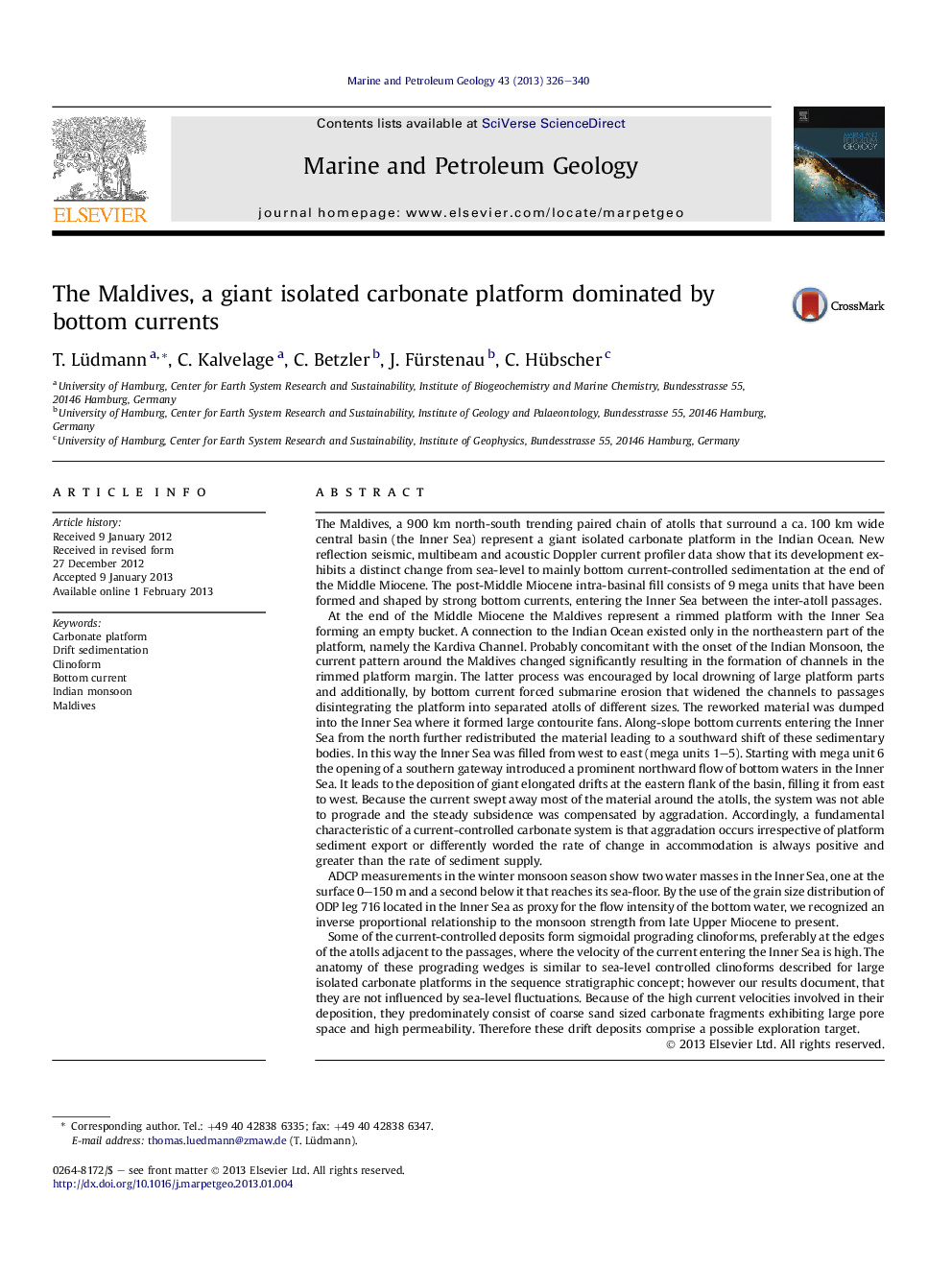| کد مقاله | کد نشریه | سال انتشار | مقاله انگلیسی | نسخه تمام متن |
|---|---|---|---|---|
| 6435547 | 1637181 | 2013 | 15 صفحه PDF | دانلود رایگان |
The Maldives, a 900Â km north-south trending paired chain of atolls that surround a ca. 100Â km wide central basin (the Inner Sea) represent a giant isolated carbonate platform in the Indian Ocean. New reflection seismic, multibeam and acoustic Doppler current profiler data show that its development exhibits a distinct change from sea-level to mainly bottom current-controlled sedimentation at the end of the Middle Miocene. The post-Middle Miocene intra-basinal fill consists of 9 mega units that have been formed and shaped by strong bottom currents, entering the Inner Sea between the inter-atoll passages.At the end of the Middle Miocene the Maldives represent a rimmed platform with the Inner Sea forming an empty bucket. A connection to the Indian Ocean existed only in the northeastern part of the platform, namely the Kardiva Channel. Probably concomitant with the onset of the Indian Monsoon, the current pattern around the Maldives changed significantly resulting in the formation of channels in the rimmed platform margin. The latter process was encouraged by local drowning of large platform parts and additionally, by bottom current forced submarine erosion that widened the channels to passages disintegrating the platform into separated atolls of different sizes. The reworked material was dumped into the Inner Sea where it formed large contourite fans. Along-slope bottom currents entering the Inner Sea from the north further redistributed the material leading to a southward shift of these sedimentary bodies. In this way the Inner Sea was filled from west to east (mega units 1-5). Starting with mega unit 6 the opening of a southern gateway introduced a prominent northward flow of bottom waters in the Inner Sea. It leads to the deposition of giant elongated drifts at the eastern flank of the basin, filling it from east to west. Because the current swept away most of the material around the atolls, the system was not able to prograde and the steady subsidence was compensated by aggradation. Accordingly, a fundamental characteristic of a current-controlled carbonate system is that aggradation occurs irrespective of platform sediment export or differently worded the rate of change in accommodation is always positive and greater than the rate of sediment supply.ADCP measurements in the winter monsoon season show two water masses in the Inner Sea, one at the surface 0-150Â m and a second below it that reaches its sea-floor. By the use of the grain size distribution of ODP leg 716 located in the Inner Sea as proxy for the flow intensity of the bottom water, we recognized an inverse proportional relationship to the monsoon strength from late Upper Miocene to present.Some of the current-controlled deposits form sigmoidal prograding clinoforms, preferably at the edges of the atolls adjacent to the passages, where the velocity of the current entering the Inner Sea is high. The anatomy of these prograding wedges is similar to sea-level controlled clinoforms described for large isolated carbonate platforms in the sequence stratigraphic concept; however our results document, that they are not influenced by sea-level fluctuations. Because of the high current velocities involved in their deposition, they predominately consist of coarse sand sized carbonate fragments exhibiting large pore space and high permeability. Therefore these drift deposits comprise a possible exploration target.
⺠In this study we investigate the sedimentation processes of an isolated carbonate platform. ⺠Since late Middle Miocene sedimentation of the Maldives is mainly bottom current-controlled. ⺠Sigmoidal prograding clinoforms at the platform margins are drift bodies. ⺠Bottom currents favour platform aggradation and hinder its progradation.
Journal: Marine and Petroleum Geology - Volume 43, May 2013, Pages 326-340
